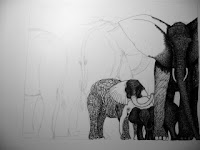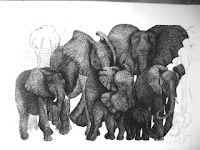Most endangered mammal in the world!!!
Rhinoceros sondaicus - Javan Rhinoceros, Sunda Rhinoceros, Lesser One-horned Rhinoceros.
Population: Fewer than 50, only one known location in the wild, Ujung Kulon NP in Indonesia.
The Vietnamese Javan Rhino officially declared EXTINCT in 2010
Dicerorhinus sumatrensis - Sumatran Rhinoceros
Population: Fewer than 200. Critically endangered.
Ceratotherium simum cottoni - Northern White Rhinoceros, Northern Square-lipped Rhinoceros, with an Einiosaurus-like horn.
Population: 7 Individuals
Now only 3 remain
Rhinoceros unicornis - Indian Rhinoceros, Greater One-horned Rhinoceros
Population: 2,949
Diceros bicornis - Black Rhinoceros
Population: 4,860
Ceratotherium simum simum - Southern White Rhinoceros, Southern Square-lipped Rhinoceros
Population: 20,600
These rhinoceros illustrations were
conceived at a time when I wanted to take a break from drawing
elephants. It wasn't so much that the elephant project was burdensome. I
just noticed that my lines were becoming sloppy. I love elephants and I
felt I was not doing them justice. I decided to read a book, Hidden
Worlds of Wildife, by National Geographic where I saw a photograph of a
black rhinoceros. I thought it looked very fierce and cool. I was not
well informed about the rhino. I decided to read and read...
It is a myth that the
rhino horn can cure among other diseases, cancer. It does
not! The horn is made of keratin, the same material found in hair and
fingernails. Rhino horn is not medicine.
In
2011, the Vietnamese Javan rhino officially became extinct when the last of the
rhinos was murdered by poachers in Vietnam. Today the Javan rhinoceros, Rhinoceros
sondaicus, is the most endagered mammal in the world with fewer than 50
individuals, in Indonesia. Closer in proximity are the Sumatran rhinos,
Dicerorhinus sumatrensis, critically endangered and remaining fewer
than 200. Also the Indian rhino, Rhinoceros unicornis, endangered and
continues to be victims of illegal poaching. The close proximity of
these animals to China make them vulnerable to poaching.
I
am not much of an activist. In fact, when I believe in a cause, I tend
to be calm about it, study it, learn more about it, share information
with a few close friends, educate my children and then quietly
contribute money or volunteer my time. There are only five extant
rhinoceros species remaining in the world, and as such, this rhinoceros
illustration project is done. However, as for helping save the rhino, I
am NOT done...please join me. I am investigating ways I can make these
illustrations serve a purpose. In the meantime, you may want to check
out these organizations and donate directly to them:































































